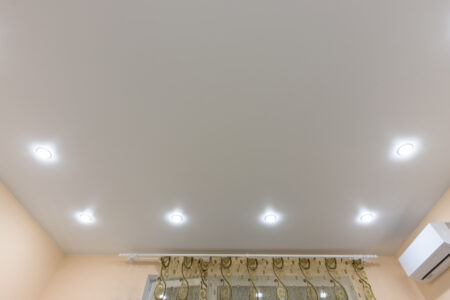The old halogen lamps change their light color when dimmed. The darker you set the light, the warmer and cozier is their color impression. On the other hand, nor LED lights retain their color temperature at any brightness. But there are also LED technologies such as WarmGlow, DimTone or GlowDim which emulate the behavior of the old lamps.
Cozy light when dimming
Especially in the living room, dimmable lamps are very popular. From the old halogen bulbs, people were used to the fact that they not only become darker when dimmed. In addition the color temperature of the old lamps with filament also changes from warm white 2700 Kelvin to extra-warm white 2000 Kelvin. This light then provides a particularly cozy ambience.
Why does the light become warmer?
With the old lamps, no additional technology is required to change the color of the light. Here this effect occurs automatically when dimming down. The temperature of the tungsten filament decreases, resulting in a warm light spectrum with a higher red content.
How do LEDs behave?
By default LED lamps only change their brightness when dimmed. The color temperature always remains the same. Many people are therefore disappointed after switching to LED lighting, because the dimmed light no longer appears as comfortable as the old halogen lamps.
Warmer light also with LEDs?
Today several manufacturers of LED lamps have developed some techniques to transfer the behavior of the old light sources to the modern LED technology. So a cozy atmosphere can be created even with dimmed LED lighting.
Manufacturer and technology for warm light
In the following table you will find an overview of all manufacturers and their techniques for producing a warm light color at reduced brightness.
Philips WarmGlow
Philips calls its technique for lowering the light color WarmGlow. LED lamps of the WarmGlow series reduce their light color from standard 2700 Kelvin at full brightness to about 2200 Kelvin when fully dimmed. You will find a wide range of illuminants with WarmGlow technology with the most different bases.
Philips DimTone
The second technology called DimTone also comes from Philips and covers a color temperature range of 2200 – 2700 K as well. In contrast to the WarmGlow series from the consumer sector, the DimTone technology is mainly used in LED lamps of the Master series. These lamps are designed for commercial use and are used, for example, in restaurants and hotels.
How does the processes work?
In order to achieve the incandescent-like effect with LED lamps when dimming, the manufacturers have to make a greater technical effort. Since a light emitting diode is always manufactured for a fixed color temperature, a combination of LEDs with different light colors is used. In most cases, another reddish LED is used in addition to the warm white LEDs.
When lowering the brightness, both colors are now mixed continuously. At 100% brightness, only the warm white LEDs shine with about 2700 K. When dimming, these LEDs become darker and the reddish LED starts to shine. The further the brightness is reduced, the darker the warm white LEDs become and the brighter the reddish LED becomes. At the lowest brightness of about 10%, often only the single reddish LED with about 2000 K is still shining.
What is the difference in the techniques?
WarmGlow, DimTone or GlowDim?
These are just the manufacturer-specific names for the method used or even for the lamp series. Basically all techniques work very similarly as described before.
Which dimmer to use?
To enjoy the comfortable lighting, the presented lamps must be connected to an LED dimmer. Existing dimmers from the old lighting usually work with phase angle control and are unsuitable for LEDs. Most LED lamps require a dimmer with phase control.
Conclusion
Whether Sunset Dimming, Dim to Warm or GlowDim. With the presented techniques of the different manufacturers, a cozy ambience can also be achieved with LED lighting. The different colored LEDs provide a smooth transition of the light color from normal warm white to a cozy extra warm white when dimming.






